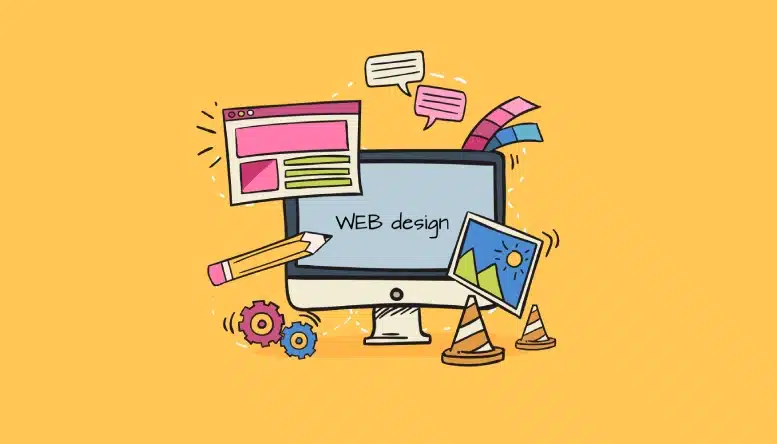Let’s get real for a moment, something that may hurt a little: your website has roughly 3.5 seconds to prove that you’re legitimate, reliable and worth your visitors’ precious time. That’s less time than it takes to reheat leftover pizza or locate your car keys in the blink of an eye during the morning rush. In those all-important milliseconds, your e-commerce e-shelf is welcoming customers or scrambling the yard with them.
Obviously, your 2015-build-and-frozen-since-before-Obama site is likely a liability. We mean bounces worse than caffeinated kangaroos, conversion rates slower than stale soda, and user experiences that make people miss dial-up internet. Ouch.
The Great Website Judgment Olympics
Here’s what happens when someone lands on your site: Within milliseconds, their brain starts making judgments faster than a food critic at a questionable buffet. Is this site trustworthy? Does it look professional? Can I actually find what I’m looking for without needing a degree in archaeology?
Sloppy web design will provoke the same immediate skepticism of quality and professionalism to hearing a squelch as you enter your average restaurant. In the meanwhile, cool and easy-to-understand design provides the digital equivalent of walking into a bright, clean, orderly store where nothing’s out of place and you really want to spend money.
The harsh reality is that your site’s guests don’t care how many thousands of dollars you devoted to your logo and how much you love your products when your site looks like it was built in the dark during a power failure. They’ll hit ‘next’ before you can even say, “but wait, there’s more!” and are most likely never to come back.
The DIY Website Hall of Fame
We’ve all seen them: websites that were clearly built by someone’s nephew who “knows computers.” These digital masterpieces feature autoplay music (because nothing says professional like unwanted noise), rainbow gradient backgrounds that could induce seizures, and enough animated GIFs to power a small carnival.
Then there are the template websites that look suspiciously similar to seventeen other businesses in completely different industries. It’s like wearing the same outfit to a party as three other people – technically you’re covered, but you’re not making the impression you hoped for.
DIY website builders promise that anyone can create a professional site in minutes, which is technically true in the same way that anyone can perform surgery with a YouTube tutorial and enough confidence. Possible? Maybe. Advisable? Absolutely not.
The Mobile Apocalypse
It’s a frightening statistic, but more than 50 percent of web traffic is now mobile, and still, so many websites treat mobile users like a gate-crasher at a party. The entire content of these sites is scaled down to microscopic sizes with the user constantly having to zoom in and out like a crime scene investigator.
A non-responsive website in the current mobile-first era is equivalent to having a brick-and-mortar shop but using only half the door. Of course a few persistent shoppers may squeeze through, but the majority will have to look elsewhere to shop and not be expected to become contortionists.
The Speed Factor (Or: Why Patience is Dead)
Modern internet users have the attention span of goldfish on espresso. If your website takes longer than three seconds to load, visitors start getting antsy. If it takes longer than five seconds, they’re already googling your competitors. Beyond that, you’re essentially running a digital haunted house – scary, empty, and avoided by sensible people.
Site speed isn’t just about user experience; it’s about search engine rankings, conversion rates, and your sanity when trying to figure out why nobody visits your beautifully designed but glacially slow website.
The Conversion Conundrum
Beautiful websites that don’t convert visitors into customers are like sports cars without engines – impressive to look at, but ultimately useless. All design elements are supposed to be functional and not just aesthetical. The role of your site is not to take home a design prize; it’s to convert interested window shoppers to paying clients.
This includes positioning call-to-action buttons strategically and making sure that you have a user-friendly site that doesn’t need a treasure map to navigate, as well as writing content that matters to your visitors and not to you.
The Professional Solution
The aesthetics of modern web design incorporate the science of psychology, technology as well as strategy to create a digital experience that’s as hardworking as your best salesman. Real designers recognize the delicate power of influencing the user’s behavior yet developing visceral experiences that present trust and provoke responsiveness.
Professional web design services transform the preparation of the website/page, starting with the basic idea to the end launch to make each pixel count. It’s the contrast between creating a sensationalist website and creating an effective website.
Ready to transform your digital presence from liability to asset? Explore the comprehensive web design services at Workvix.com and discover how strategic design can turn your website into a customer-converting machine.
Because in today’s competitive digital landscape, a great website isn’t a luxury – it’s survival.



